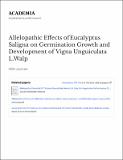| dc.description.abstract | Allelopathic effects of Eucalyptus are widely reported and considered the major factor limiting the
establishment of native species in eucalyptus forest. Allelopathy is used here to refer to the inhibitory and
stimulatory effects of one plant species upon another by the compounds arising from the products of their
metabolism. Improved germplasm of Eucalyptus developed through traditional breeding, tissue culture
technique and other biotechnology researches are becoming an attractive alternative to other hardwood tree
species for wood, pulp and paper, and bioenergy applications in many countries. In Eucalyptus plantations
established for research and commercial end use, allelopathy has been raised as a concern for possible negative
effects on crops grown in local areas, especially in agroforestry systems. In this study Eucalyptus saligna is
used. E. saligna is thought to possess phenolic acids released from the leaves, bark and roots that have
deleterious effects on other plant species. Cowpea (Vigna unguiculata L.Walp), an annual legume which
originated in Africa is widely grown for grain crop, animal fodder and as a vegetable. The main objective of the
study was to determine the allelopathic effects of Eucalyptus saligna on the germination, growth and
development of Vigna unguiculata L. Walp. The study was conducted at Maseno University, Kenya, to
investigate specifically the allelopathic effects of E. saligna on the percentage germination of seeds, rate of
germination, growth of different parts of the plant species and synthesis of chlorophyll of seedlings of cowpea
(Vigna unguiculata). Cowpeas seeds were subjected to four different concentrations of the fresh shoot aqueous
extracts which comprised of 0% (distilled water), 25%, 50%, 75%, and 100%. Ten seeds of cowpeas were
germinated in sterilized petri dishes lined with a layer of filter paper Whatman no. 1, moistened with 10ml of
each of the 0%, 25%, 50%, 75% and 100% extract aqueous concentration,respectively. Germination percentage
were determined at the end of the study. Individual cowpeas seedlings were planted in 4.5 litres plastic pots
containing soil and irrigated with different amount of eucalyptus fresh shoot litter extracts (25g, 50g, 75g, 100g)
and 500ml of distilled water. The treatments were replicated five times and the pots laid out in a completely
randomized design in the glasshouse. Data on shoot height and number of leaves per plant was recorded on
weekly basis. Leaf area, shoot and root dry weights and leaf total chlorophyll, chlorophyll a and b
concentration were determined at the end of the experiment. Data collected was subjected to analysis of
variance (ANOVA) using SAS statistical package. Treatment means were compared using the least significant
difference (LSD) at (P≤0.05). The results revealed that the shoot litter of E. saligna has both inhibitory and
stimulatory effects on Vigna unguiculataat differentstages of plant growth and development. Seed germination
decreased with increasing concentration of shoot extracts from 25%, 50%, and 75% to 100% even though there
were no significance differences among treatments. Shoot heights, leaf number, leaf area, shoot and root dry
weights, total chlorophyll increased significantly with increasing fresh shootextract aqueous concentration. This
research data can be used to inform agriculturist, farmers, policy makers and advisers on the consequences of
E. saligna in the agroforestry programmes. Further, the results can be used at an advisory level to inform
efficient and effective use in the agroforestry systems to improve crop bioproductivity for increasing population
in the world. | en_US |

